This is an issue close to my heart, as I have a lower back injury. Over my years of weaving, I’ve had to find the best ways to avoid pain while being able to indulge in as much weaving as possible.
The more time you spend thinking about and implementing comfortable weaving, the more time you will be able to spend actually doing it into the future.
Firstly I’m going to talk about seating.
There are a few important factors here. Generally, a regular chair cannot be used for weaving on a floor loom, so we have to look at the best suitable alternatives.
So, what are these alternatives?
Most floor loom manufacturers also make weaving benches that can be purchased separately but are made specifically for your loom. Benches can be very pricey.
I’ve seen some weavers seated on exercise balls for threading the loom, which allows you to get very close to the shafts – I don’t intend to try this myself, but it’s another option.
I have been fortunate to find the perfect seating option for me. I use an adjustable, padded piano bench. Let me tell you why I love this option:
- It’s height adjustable.
An adjustable bench is important because it allows you to adjust your seated height to suit the loom. Your posture at the loom is crucial to your long term back health. Your elbows should be able to rest on the front cloth beam without you having to raise them up. Your hips should be higher up than your legs (like they are when you’re driving a car) because otherwise you’re going to have to exert more pressure when treadling and then – hello back pain!
2. It has ample seating space.
When I was looking at buying a weaving bench, all I could think when I saw commercial weaving benches is “they obviously weren’t built for weavers with generous lower proportions!” The piano bench accommodates my… ahem… ample behind (🙈) very well because it is wide enough, but not so wide as to be a difficulty.
3. It’s padded.
I can’t imagine sitting on a non padded bench, ouch. If you can get something with padding built in, that is better because you don’t have to contend with it slipping around.
4. It has 4 legs.
This is really useful for the threading stage, as I can angle the bench so that two legs sit inside the front of the loom, allowing me to be closer to the shafts and therefore putting less strain on my back.
If you purchase an adjustable piano bench, try to spend a bit more to get good quality. I did not do this, and am constantly having to tighten bolts because the bench is not as stable as I would like. Eventually I’ll invest in a good one!
Also, don’t get the cheap, fold out piano bench. I do have one of these for my kids to use at the piano, and it’s surprising strong, but you want a bench with four legs, as I already mentioned.
Now let’s discuss some other tips and strategies for keeping your back pain free at the loom.
If you already have pain:
- Firstly, if your lower back is on fire REST IT! I can’t stress this enough. Do not sit at that loom again until your back has settled down, you will only make it worse. I know it’s hard to take a break but it really is necessary.
- Take anti inflammatories if needed, use ice or heat – whatever works for you to get your back moving towards normal again. If you’re using medications due to a flair up, do it sensibly and in consultation with a medical professional.
- If your flare up does not settle down, you may need to see someone who can help you. This may be a chriopractor, a physical therapist, a masseuse – there are options to try and you don’t have to suffer alone!
As you weave: - Try to move a little or shift your weight from side to side as you weave rather than keeping your body really rigid – follow the shuttle with your body, especially if it’s a wide warp.
- Throw and catch your shuttle in a way that is not causing you to raise your arms unnecessarily or at weird angles.
- Get in close to the loom. The closer you are, the nearer your reach. You can also naturally brace yourself against the breast beam to beat.
Treadle positioning:
A couple of years ago we bought a new (secondhand) van following an accident where our existing van was written off. The new van was the same company and make as the last one, but was a slightly updated model.
As soon as I began driving the new van, I noticed a difference in the height of the accelerator. The new accelerator was so much higher than the old one! I had to lift my foot higher to depress the pedal. And, guess what? Yep, the hip pain started up and is still a problem. I try to limit my driving, but when I do drive I use cruise control as much as possible so that I’m not having to lift my right foot so much.
My point? The higher you have to lift your feet to operate your treadles, the more stress you will place on your legs and ultimately, your back. If your treadles are very low to the floor (as they are for my floor loom) you will not have that stress on your body.
You may find that older looms not only have treadles sitting high, you also have to depress them quite firmly. If you do have an older loom, I recommend looking at any modifications you can do to get those treadles lower to the floor.
Take regular breaks.
It’s tempting to stay in the weaving groove and forget about time, but breaks are necessary. Get up, walk, stretch. Don’t sit at the loom for so long at one time that you feel sore and stiff when you get up. Anticipate the stiffness (even set a timer if you need it) and be kind to your body by resting it.
Batching tasks:
This goes hand in hand with the last point on taking breaks. Plan out your project so that you can batch tasks.
For example, if you’re threading for a full width project, unless you are Speedy Gonzales, you have to expect that the threading will take several hours. Plan to do a certain amount at one time or on one day. Make an agreement with yourself like: “Today I will aim to thread half of this project, taking regular breaks. If I start to experience pain, I will stop or only do a quarter of the threading”. You’re still making progress, but you’re not overdoing it.
Another example: “I will aim to make my warp today, dress my loom tomorrow, do half of the threading the next day and the second half the following day etc”. Break the tasks down to keep them achievable. You may end up doing more than you planned because you are pain free, but the point is to have a plan in place.
Accept bodily limitations:
This is a hard one! I’m sure we all wish that we were completely fit, healthy and pain free. But we need to be realistic and accept that we are not perfect. Accept the physical limitations you may have and don’t push yourself beyond them. Work with what you can do and make that your focus.
Sit up straight!
Did you ever here those words from your mother at the dining table? Well, she was right! 😆 You want to sit naturally, not rigidly at the loom, but you also want to keep your back nice and straight. If you find yourself slumping often, go back and check the seating points I discussed. It may be that your bench is not at a correct height.
Overall loom posture is really important. Remember – elbows on the breast beam, hips higher than knees, back straight!
I hope this post has been helpful to you. I have made a companion video so you can see just how I sit at my loom. You can view that here:
If you want to get started in floor loom weaving, my Introduction to Floor Loom Weaving course is perfect. It takes you through step by step processes to give you the confidence to get weaving!
Want to know more about my floor loom? Check out my review by clicking here.
Let’s keep the conversation going! Do you have any helpful tips to add? Any questions? I would love to hear from you in the comments.
Until next time…
Happy Weaving!

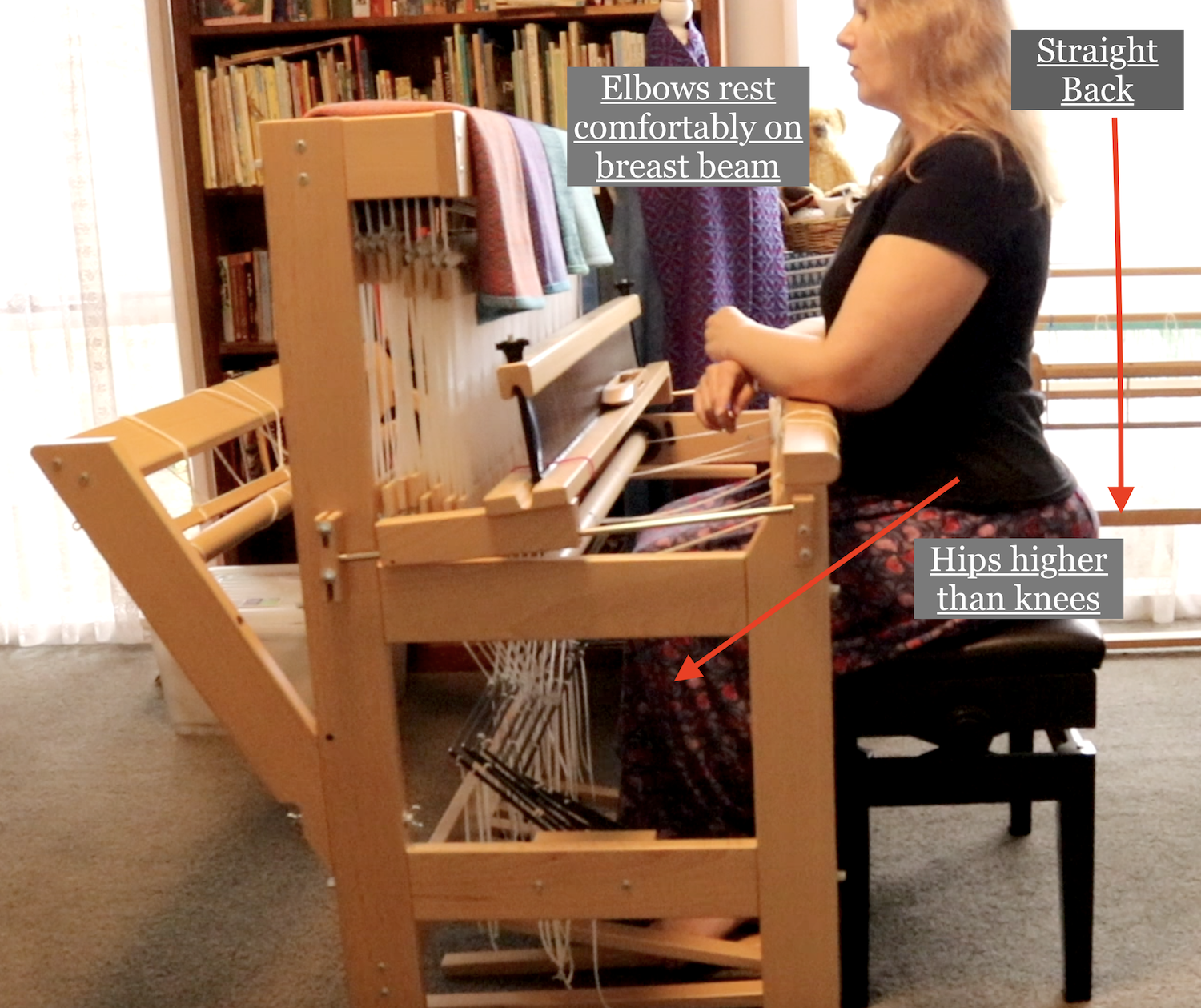
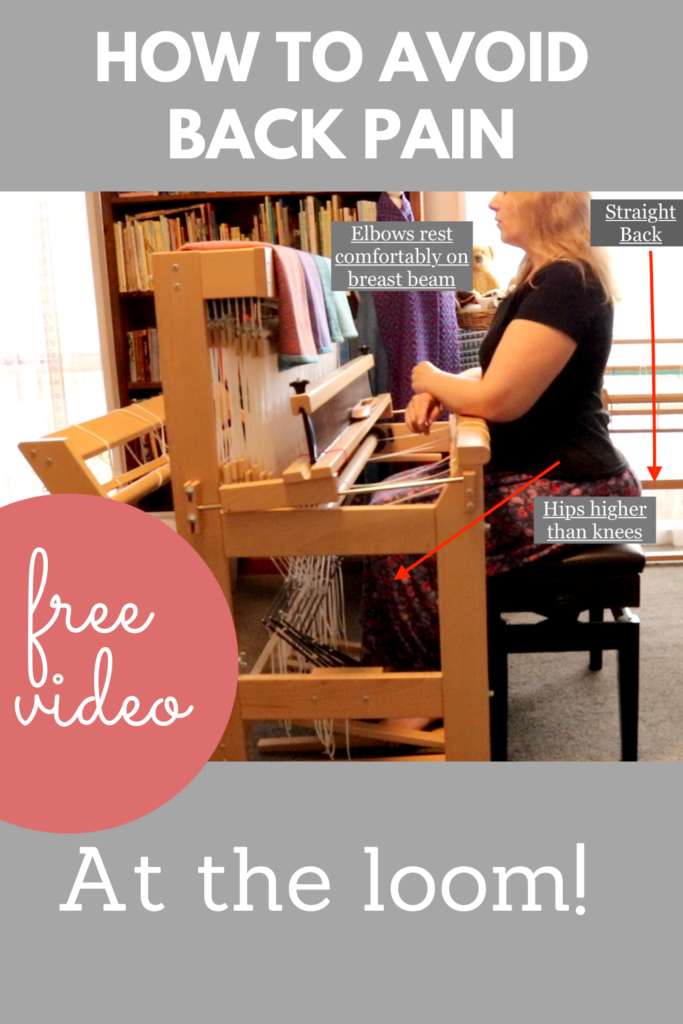
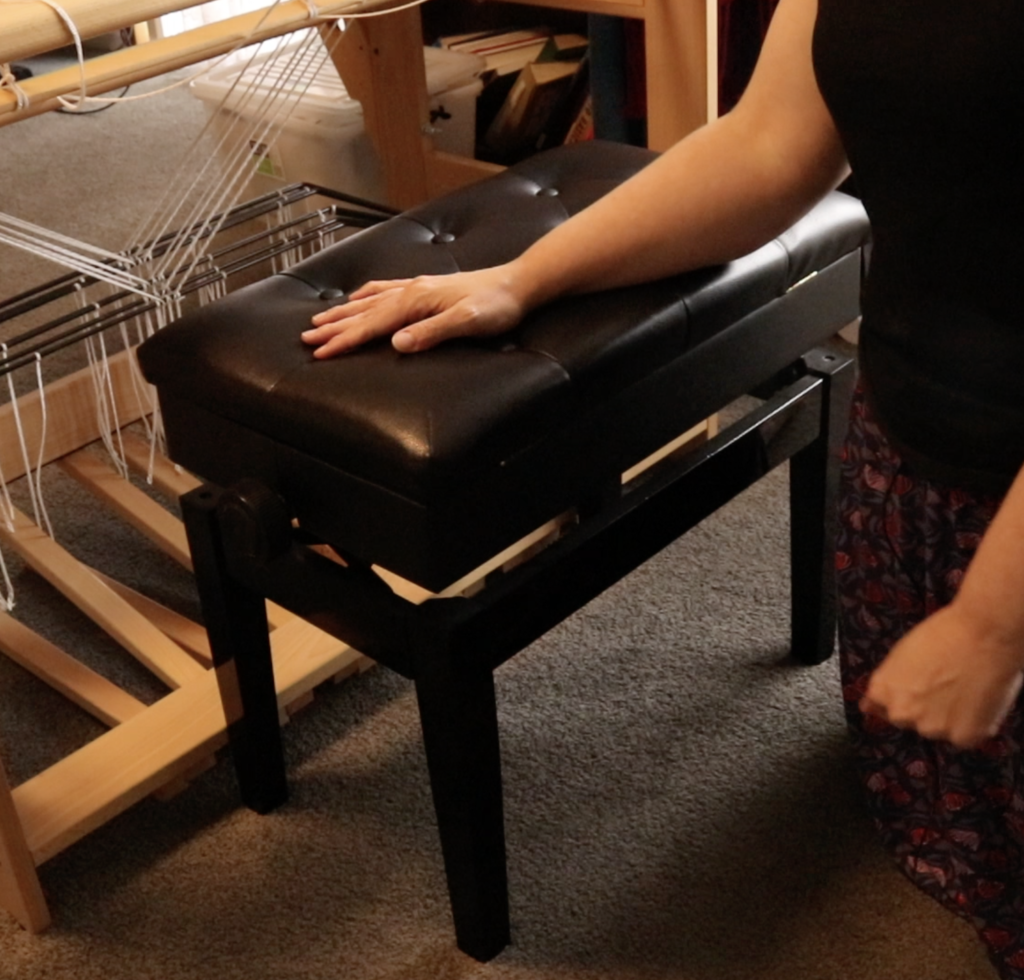

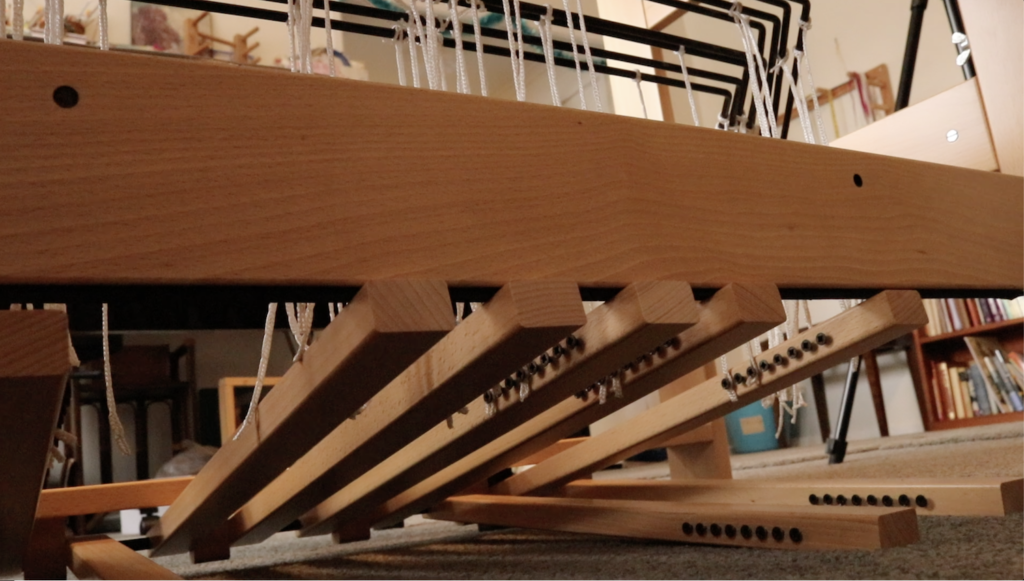
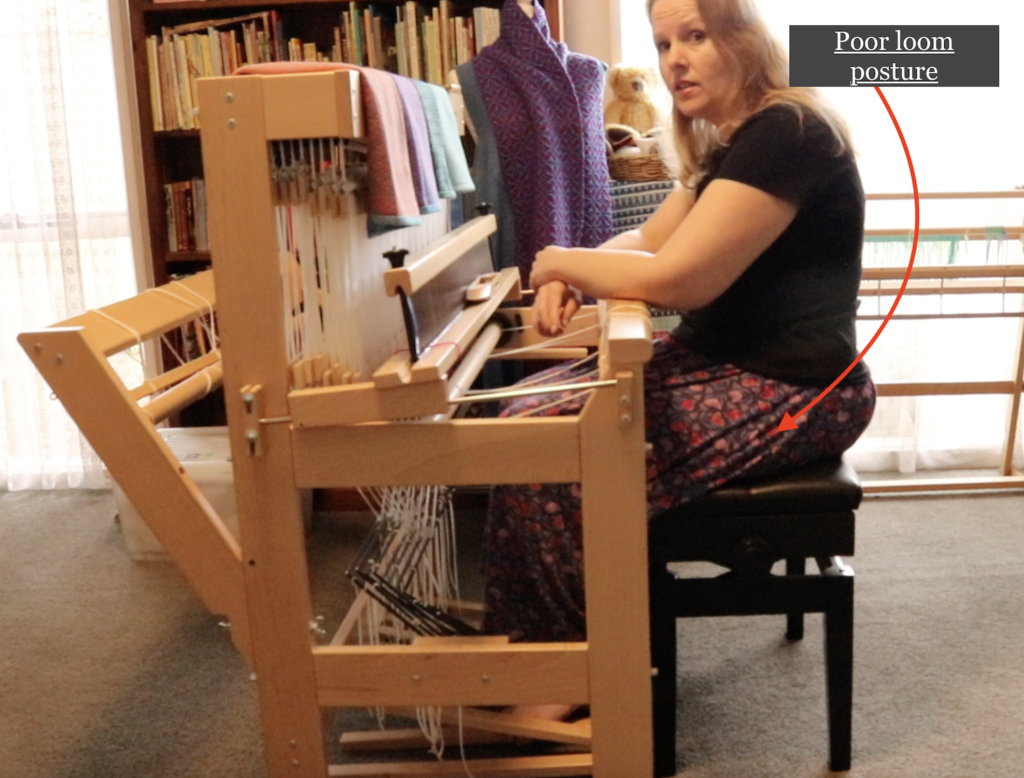
Would you have any pointers for neck issues. So much of our work involves looking down and with disc issues this is an activity that can cause further damage. Taking frequent breaks and stopping helps, but it really makes a piece take a loooknnngg time.
Any suggestions would be welcome!
Cheers!
Hi Amy,
I don’t have permanent neck issues but I do get neck and shoulder pain, mostly from repetitive tasks. I guess the first thing I would be thinking about is “can I do this task any differently?” For example, I know that lifting heddle rods will cause me neck pain if I do it enough, so I usually opt for an additional heddle or pick up stick instead.
I know it’s frustrating, but I do think that breaks and rest are the absolute best treatment when things are flaring up.
Also, treatment from a professional if the problem is affecting your work so much, can be really worthwhile.
Thank you for this info and video. It was very helpful.
That’s great to hear Wanda, thank you!
Kelly,
As one who also has back problems, thank you! Take your van to your mechanic and have him make an extension for your gas peddle.
I didn’t know you could do that!
I think they can also adjust the height – I got my car back after some work, and the accelerator was much higher, and difficult to use, I mentioned it, and they lowered it for me back to where it had been. I don’t know where you live, but I know a great mechanic in Upwey 🙂
That’s good to know, thank you!
How about those of us who work with rigid heddle looms? We usually use our feet to steady the stand or rest the loom up against a table. Any tips for us? And thank you Kelly for addressing this very important subject.
Yes, actually, due to popular demand, I’ll also be making a video and blog post for RH weavers 😊
Perfect timing Kelly, I am trying out new seats for my floor loom and am currently using an office chair. I have to remember to keep lordosis in my back or I have a VERY restless painful nights sleep. I have tried a little adjustable chair with wheels ( offline) But it is too small for my bum and painful to sit on for long. I love your idea of an adjustable piano stool. Thanks for sharing your ideas.
The most important thing I see in this article other than giving your back breaks and resting, is adjustable seating. Height adjustability is so important. My cheap chair is height adjustable and has some lumbar support which is very helpful. I say cheap because I got it at a thrift shop for $2.00 (my grandson was working there and got it for me). I’m sure it was probably expensive when it was new. Anyway, I recovered the chair and it took me a bit of time, but I have finally gotten it to just the right height setting for my loom. It has made all the difference in the world. I still take breaks as needed and I do use my heating pad a lot, but I can weave for a bit longer stretches now than I could before. I need the backrest, but if you don’t, Kelly’s piano bench sounds really good. Happy weaving y’all.
Wow, you really got a bargain with your chair!
Such great advice Kelly. I never weave for more than an hour without getting up and walking around and find 30 minutes is even better. I’m going to try the hips higher than knees both at my rigid heddle loom and in my car and see if this helps my hip pain. I have a daily 22 minute stretching/strengthening/flexibility routine called Classical Stretch that really helps especially as like many if us I had to give up in person classes.
I’m going to do another video specifically for rigid heddle weavers, as a lot of people are asking for it 😊
thanks for looking after us Rigid Heddle Weavers also Kelly. Look forward to your advice.
Kelly, thank you for such a great post! I have multiple pain issues that at first, I thought I would not be able to weave anymore. But I have learned that exercising daily keeps the pain away and I’m back to weaving again! My body needs almost constant non-repetitive motion to be happy and pain-free. My total daily exercise time is about an hour, broken up into small chunks which works out any kinks that develops during my weaving. It was hard to make exercise a higher priority than the things I enjoy, but with the restrictions on going places, exercise has become “an approved activity” that is good for us no matter what.
You’ve made a really important point there too LaDonn, that we each need to find the specifics that work for us individually. Yes, exercise of some sort is always going to benefit, but which exercises and how we do them is not going to be the same for everyone. I’m glad you’ve found a way to work through the pain!
Thank you Kelly. I have my RHL on a stand and use an adjustable office chair. My back is fine but I find my neck becomes painful after sitting for a while at the loom. I now take regular breaks (darn) and it does settle down. I’m just wondering if anyone else has mentioned this problem or is it just me. Thanks
Kelly, This video came out at such a great time. The past several days our weather has changed from 70’s to low 40’s and North winds and rain. I started having hip, lower back and hamstring pain. I started doing stretches in the last 24 hours and over the counter medication for it. Then here came your email with video and tips that was right on the point. Thank you for sharing your experiences and remedies. I’m planning to keep stretching and add exercises to help strengthen that area so I can keep weaving and knitting.
It’s great that you’re onto it Tracy!
Thank you Kelly
You are my “go to” teacher! You have brought me from a non weaver to regid heddle weaver, for 5 years, now moving on to a floor loom, I have low back (lumbar) scoliosis, severe, so back pain is my life. I was worried about the bench until I saw your piano bench working so wonderfully. Only question I have is about no back support. Do you think that would help or not? Obviously posture is crucial no matter what. Keep up the great work you are a blessing to so many!
From Idaho USA
Thanks for the kind words 😊
Lack of back support can be an issue at the floor loom, but as far as I know, a bench style seat is the only type that is going to be compatible with the loom layout. I find that, when using a bench seat, I need to take more frequent breaks and not weave for as long.